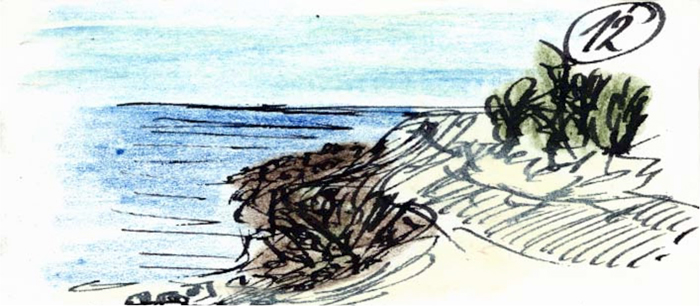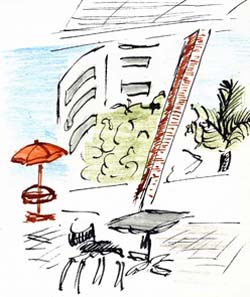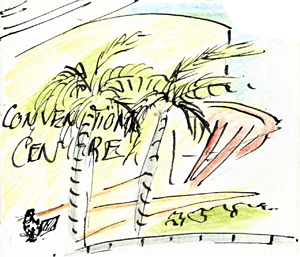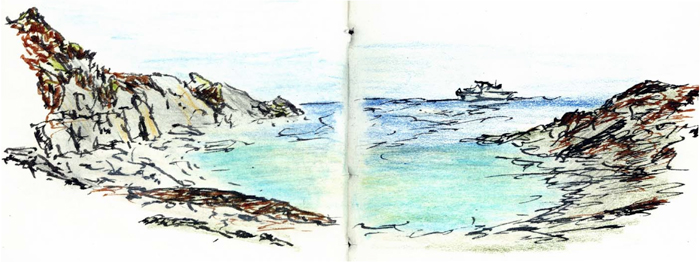4th International Conference, Australia, 2007 – Conference Report

4th International Conference, Australia, 2007 – Conference Report
The international meeting of IGCP495 combined with the 2007 INQUA Congress in Cairns (Australia)
Fourth International Meeting
Cairns, Queensland, Australia
28th July – 3rd August, 2007
The programme included much of interest to coastal scientists, a selection of which is listed below, as well as several fieldtrips before and after the conference (see below for details of a formal post-conference joint IGCP 495 / INQUA field meeting).

Conference Report
This year the annual meeting of IGCP Project 495 (Quaternary Land-Ocean Interactions: Driving Mechanisms and Coastal Responses) was held during the INQUA Congress in Cairns, Australia. The meeting was co-organised by the Coastal and Marine Processes Commission (CMP) of INQUA.
The meeting included two formal IGCP-495 sessions:
Late Holocene Sea-level and Climate (Sunday-Monday, July 29th – 30th)
Conveners: Professor R. Gehrels, University of Plymouth, UK; Professor A. Long, University of Durham, UK; Professor C. Murray-Wallace, University of Wollongong, Australia. (13 oral presentations, 7 posters)
Late Quaternary Coastal Changes – Sea level, Sedimentary Forcing and Anthropogenic Impacts (Thursday-Friday, August 2nd – 3rd)
Conveners: Dr C. Baeteman, Geological Survey of Belgium; Professor A. Long, Durham University, UK. (37 oral presentations, 27 posters)
The initiative to combine the IGCP meeting with the INQUA Congress proved extremely successful, as testified by the high number of scientific papers presented. The session organisers are to be congratulated on all their efforts in stimulating so many colleagues from around the world (participants from 24 countries) to share their exciting investigations with each other under the umbrella of IGCP-495. As always, it was great to meet new inspiring coastal researchers and to see many familiar faces.

Session 1: Late Holocene sea-level and climate
The scientific session began with a warm welcome from Roland Gehrels (UK) and an extremely interesting keynote lecture by Ian Goodwin (University of Newcastle, Australia). Ian presented a 1000 year long reconstruction of the Interdecadal Pacific Oscillation (IPO) as a framework for interpreting wave climate and sea-level changes in the southwest Pacific region. The second paper of the session was joyfully presented by Kaj Petersen (Denmark), who discussed new mollusc data recording environmental change in the Danish Baltic during the Roman Warm Period. The question ‘Has there been a global rise in sea level in recent decades?’ was vividly argued and, to the astonishment of most of the audience, answered with ‘no!’ by Nils-Axel Mörner (Sweden). This hypothesis contrasted sharply with the following two papers. Ben Horton (USA) showed sea-level data for the Bay of Biscay (Spain/France) that provided evidence for an acceleration in the rate of sea-level rise during the last 150 yrs. The development of quantitative reconstructions of sea-level change based on transfer functions has been a major theme of the last three international meetings of IGCP 495, a tradition continuing during this meeting. Roland Gehrels demonstrated this approach in his reconstruction of a New Zealand and Australian salt-marsh sea-level record, showing a rapid sea-level rise during the past century, a phenomenon also vividly discussed during the post-conference fieldtrip. Sarah Woodroffe (UK) addressed the potential of modern salt-marsh sediments in western Greenland for the development of a microfossil-based transfer functions for sea-level change reconstruction. Katie Szkornik (UK) presented a seal evel curve for western Denmark using diatoms as indicators. In the light of increasing usage of quantitative techniques, she emphasised the necessity of not neglecting the lithological framework. Antony Long (UK) presented the first high-resolution record of late Holocene sea-level change from west Greenland. These sea-level data provide constraints on the timing and magnitude of the Greenland Ice Sheet re-growth during the Neoglacial and a long-term context for the abrupt changes in ice-sheet dynamics in response to climate change. Juan Gonzalez (USA) demonstrated the link between elevated palaeo-temperatures and accelerated sea-level rise during the Medieval Warm period through the construction of a high-resolution sea-level chronology, using basal peat from the Mississippi Delta as a tracer of sea level.
On Monday morning, the two final papers of the Holocene sea level and climate session were scheduled. Callum Firth (UK) gave a presentation on glacio-isostatic uplift and sea-surface changes during the last 8000 years in the UK and Ireland. Robert Baker (Australia) discussed fixed intertidal biological indicator, beach rock and relic corals evidence for a mid- Holocene 1 to 2m higher relative sea level stand in Australia and SE Asia.


Session 2: Late Quaternary Coastal Changes – Sea level, Sedimentary Forcing and Anthropogenic Impacts
- It is beyond the scope of this report to mention all the contributions to this very popular session, keeping some of us locked up for two full days in the same meeting room. However, time flew as we were provided with some high-quality and innovating research. On Thursday, Cecile Baeteman (Belgium) opened this megasession with a word of thanks to all the participants. A keynote address was delivered by Ron Boyd (Australia), who presented an excellent overview of the state-of-the-art knowledge of the driving forces of coastal behaviour. He concluded that a next challenge for coastal scientists is to use sea-level and sediment-flux data to determine climate and tectonic forcing. Moreover, the use of climate and tectonic inverse modelling can help us to predict future coastal change, a necessity in view of future sustainable policy making.The following presentations in this session, by PhD students and researchers from developing countries, deserve to be highlighted:
- Late Quaternary relative sea-level change and crustal movements of the eastern seaboard of the United States (Simon Engelhart, USA)
- Beachrocks as indicator of relative sea-level changes since the mid-Holocene on the southern coast of Turkey (Stephane Desruelles, France)
- Sedimentological evolution of a paleo-lake during the Pleistocene according to carbonate and evaporitic mineral occurrences (Kosmas Pavlopoulos, Greece)
- Land-sea correlation of Tagus River (Portugal) sedimentation: Evidence of strong human impact (Geert-Jan Vis, The Netherlands)
- Changes of Tidal flat Morphology for the Period (14 years) of the Construction of the Saemangum Tidal Dam, West Coast of Korea (Yong Ahn Park, Korea)
- Sand grains transport around river mouth revealed by OSL measurement technique (Masaaki Shirai, Japan)
- Late Quaternary stratigraphy and development of tidal sand ridges in the eastern Yellow Sea (Soo Chul Park, Korea)
- Coastal geomorphology and luminescence chronology of coastal dunes in Maputaland, Mozambique (Fatima Momade, Mozambique)
- Holocene Coastal evolution in North and South Coast of Central Java, Indonesia: data from Satellite Image, DEM, Seismic profiling and Drilling (Wahyoe Hantoro, Indonesia)

A full list of papers, including posters and abstracts, can be found on the conference website at: http://www.icms.com.au/inqua2007/grid.asp
Post-conference fieldtrip: ‘Searching for the Mid Holocene Sea-level High stand in the Central Great Barrier Reef Region, North Queensland.’ (Friday – Monday, 3rd – 6th August)
This post-conference fieldtrip was extremely well organised by Dr Sarah Woodroffe (University of Durham, UK), who recently completed a PhD in this area, in collaboration with Dr Scott Smithers and Professor David Hopley (James Cook University, Australia). The fieldtrip was attended by 24 people from 12 countries and comprised three days of travelling along the Great Barrier Reef coast between Townsville and Cape Gloucester, Queensland. The fieldtrip focussed on the identification and the discussion of evidence for a mid-Holocene sea-level high stand in the Central Great Barrier Reef area. A relative large number of sea-level data are available for this region, but questions remain regarding the exact timing of the start and the amplitude of the high stand because of the paucity of good quality sea-level data during the early Holocene. Evidence addressed during the fieldtrip included fixed biological indicators, raised beach-rock deposits and new microfossil data from intertidal soft sediments.
On Friday evening, delegates were transported by bus to Townsville, a coastal town well known for the tropical Magnetic Island, located just offshore. On Monday morning we climbed Castle Hill for a spectacular view over the Cape Cleveland and Cleveland Bay coast. Sarah Woodroffe explained to us the coastal morphology of the area and told us that we would spend the rest of the day at Cocoa creek, one of the areas where she had been working on her PhD research. Only one hour later, a 4×4 drive took us through an impressive chenier plain, and after a lot of bumping we arrived at the mouth of the creek. When everybody was ferried down and prepared for the battle against the mosquitoes, our mangrove expedition started with a splendid walk (up to our knees in the mud) during which we were introduced to the different mangrove environments and species, typical for the dry tropics in North Queensland. It was impressive to see in which difficult field conditions Sarah had been working, especially if you know the excellent research results she got out of it. Indeed, Sarah was able to develop a quantitative reconstruction of RSL change in the area based on transfer functions. The latter approach is based on the statistical relationship between contemporary microfossil assemblages and their fossil counterparts identified in sedimentary successions. The established sea-level curve suggests that sea level rose to a maximum of between 1-2m above present with a high stand formed by 5500 cal yrs BP. Sea level continued to be relative stable at 1-2m above present into the late Holocene, with a fall to present in the last 2000 years. In the afternoon we got even dirtier while coring in small groups through a mid-late Holocene inter-chenier sediment sequence. By 4 pm it was time to leave Cocoa Creek and we drove to our overnight stop at Cape Gloucester Eco Resort.
On the second day of the fieldtrip our focus shifted to examining fixed biological and sedimentological evidence for the mid Holocene high stand on the offshore islands in Edgecumbe Bay. At 7 am the first group of delegates was gathering on the beach for transfer on a small boat to Middle Island. The (very) bumpy ride brought back memories of the IGCP boat trip to the Krakatau volcano during the international meeting in Indonesia in 2005. This time we experienced a tropical thunderstorm and a shortage of fuel, which made some of us feel less confident in the early morning. However, everything went well, despite the fact that, following IGCP-495 tradition, the boat engine stopped several times and the captain looked more and more worried. When the final group had arrived on Middle Island, we walked to the southern side of the island, which is marked by a largely dead reef flat. David Hopley guided us along a number of large eroded micro-atolls in position of growth and showed three discrete beach rock suites. David explained that the micro-atolls indicated a mid-Holocene sea-level high stand around 5200 yrs BP of 1-1.5 above present sea level. The maximum of the transgression was reached by 4500 yrs BP when a beach ridge developed across the reef enclosing a marshy depression. A lowering of sea level occurring by 3800 yrs BP caused the development of a lower cemented beach banked against the barrier. More eastward, we observed a modern example of a beach ridge and an enclosed mangrove vegetated lagoon. Moreover, a high boulder beach characterised by boulders with a diameter of 50 cm and clear deposition zones of pumice (from Vanuatu) were observed. Cyclones and storm surges are considered responsible for these features.
Our lunch was taken at a beautiful bay along the northern side of the Island, and participants could enjoy a cooling swim and snorkelling on the modern reef. In the afternoon the groups were shuttled back to Cape Gloucester, from where we left around 5 pm. In the evening we arrived in Bowen where we enjoyed a delicious conference dinner and a presentation by David Hopley about the Burdekin Delta. On the third day of the fieldtrip we investigated the Burdekin River and Delta region, a major sediment source for the central Great Barrier Reef shelf. Near the Whitsunday Resort where we had stayed that night, Robert Baker showed us oysters and tubeworms fossils positioned in a cave 1.5-2m above present sea level. A lively debate started about the precision of these indicators for sea-level reconstruction, especially in an area dominated with a 3m tidal range.
Sediments derived from the Burdekin had a major impact on coastal evolution in the central Great Barrier reef area, allowing the development of extensive beach ridges and chenier plains. The mouth of the delta has been in its present location only since the mid-Holocene sea-level highstand. The 14m long Inkerman Pleistocene calcarenite dune is an example of a Pleistocene beach ridge, truncated at its southern end by a former distributary of the Burdekin. We had lunch at the Mount Inkerman Lookout, from where we had a splendid view on the Burdekin delta. At the last stop of this fieldtrip, at Alva beach, we were confronted with the highly dynamic processes of the Burdekin delta which produced many shifts of the position of the spit. On behalf of the delegates who attended this fieldtrip, it remains to pay a heart-felt thanks to the organisers Sarah Woodroffe, Scott Smithers and David Hopley for running such a magnificent fieldtrip. All of us have fond memories of this fieldtrip for many years to come.

Further information on IGCP495 “Quaternary Land-Ocean Interactions: Driving Mechanisms and Coastal Responses” can be found from the UK National Correspondent, Dr Roland Gehrels (University of Plymouth, [email protected])
Dr Vanessa Heyvaert
Geological Survey of Belgium
Images reproduced by kind permission of
Kaj Strand Peteren
Department of Quaternary Geology
Geological Survey of Denmark and Greenland